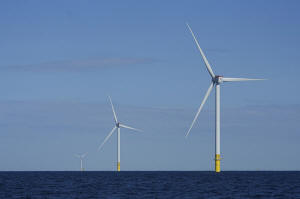States sue Trump administration for blocking the development of wind
energy
[May 06, 2025]
By JENNIFER McDERMOTT
A coalition of state attorneys general filed a lawsuit Monday against
President Donald Trump's attempt to stop the development of wind energy.
Attorneys general from 17 states and Washington, D.C., are challenging
an executive order Trump signed during his first day in office, pausing
approvals, permits and loans for all wind energy projects both onshore
and offshore. They say Trump doesn't have the authority to unilaterally
shut down the permitting process, and he's jeopardizing development of a
power source critical to the states’ economic vitality, energy mix,
public health and climate goals.
They're asking a federal judge to declare the order unlawful and stop
federal agencies from implementing it.
“This arbitrary and unnecessary directive threatens the loss of
thousands of good-paying jobs and billions in investments, and it is
delaying our transition away from the fossil fuels that harm our health
and our planet," New York Attorney General Letitia James, who is leading
the coalition, said in a statement.
White House spokesperson Taylor Rogers said Democratic attorneys general
are “using lawfare to stop the president’s popular energy agenda,”
instead of working with him to unleash American energy and lower prices
for families.
“The American people voted for the president to restore America’s energy
dominance, and Americans in blue states should not have to pay the price
of the Democrats’ radical climate agenda,” Rogers said in a statement to
The Associated Press.

Trump vowed during the campaign to end the offshore wind industry if he
returned to the White House. His order said there were “alleged legal
deficiencies underlying the federal government’s leasing and permitting”
of wind projects, and it directed the Interior secretary to review wind
leasing and permitting practices for federal waters and lands.
The lawsuit was filed in federal court in Massachusetts.
Trump's order targeted a priority of Biden's climate plan
The Biden administration saw offshore wind as a climate change solution,
setting national goals, holding lease sales and approving nearly a dozen
commercial-scale projects. Trump is reversing those energy policies.
He's boosting fossil fuels such as oil, natural gas and coal, which
cause climate change, arguing it's necessary for the U.S. to have the
lowest-cost energy and electricity in the world.
The Trump administration took a more aggressive step against wind in
April when it ordered the Norwegian company Equinor to halt construction
on Empire Wind, a fully permitted project located southeast of Long
Island, New York, that is about 30% complete. Interior Secretary Doug
Burgum said it appeared the Biden administration rushed the approval.
Equinor went through a seven-year permitting process before starting to
build Empire Wind last year to provide power to 500,000 New York homes.
Equinor is considering legal options, which would be separate from the
complaint filed Monday. The Norwegian government owns a majority stake
in Equinor.
[to top of second column]
|

Wind turbines of South Fork Wind are seen off the coast of Block
Island, R.I., Oct. 9, 2024. (AP Photo/Seth Wenig, File)

Wind provides about 10% of the electricity generated in the United
States, making it the nation’s largest source of renewable energy.
The attorneys general argue that Trump’s order is at odds with years
of bipartisan support for wind energy and contradicts his own
declaration of a “national energy emergency,” which called for
expanding domestic energy production.
States have already invested large sums to develop wind energy
The coalition includes Arizona, California, Colorado, Connecticut,
Delaware, Illinois, Maine, Maryland, Massachusetts, Michigan,
Minnesota, New Jersey, New Mexico, New York, Oregon, Rhode Island,
Washington and Washington, D.C. They say they've invested hundreds
of millions of dollars collectively to develop wind energy and even
more on upgrading transmission lines to bring wind energy to the
electrical grid.
New York Gov. Kathy Hochul said the executive order sows chaos, when
businesses need clear regulations to effectively operate.
Large, ocean-based wind farms are the linchpin of state plans to
shift to renewable energy, particularly in populous East Coast
states with limited land. The nation’s first commercial-scale
offshore wind farm opened a year ago, a 12-turbine wind farm east of
Montauk Point, New York. A smaller wind farm operates near Block
Island in waters controlled by the state of Rhode Island.
Massachusetts has invested in offshore wind to ensure residents have
access to well-paying green jobs and reliable, affordable energy,
Massachusetts Attorney General Andrea Campbell said. The state has
three offshore wind projects in various stages of development,
include Vineyard Wind. The U.S. Supreme Court on Monday denied to
hear a case brought by fishermen's organizations challenging the
approval of Vineyard Wind.

The Trump administration has also suspended federal funding for
floating offshore wind research in Maine and revoked a permit for a
proposed offshore wind project in New Jersey.
Elsewhere, political leaders are trying to rapidly increase wind
energy. U.K. Prime Minister Keir Starmerannounced a major investment
in wind power in April while hosting an international summit on
energy security. Nova Scotia plans to offer leases for five
gigawatts of offshore wind energy by 2030, Nova Scotia Premier Tim
Houston said in Virginia last week at an Oceantic Network
conference.
All contents © copyright 2025 Associated Press. All rights reserved |